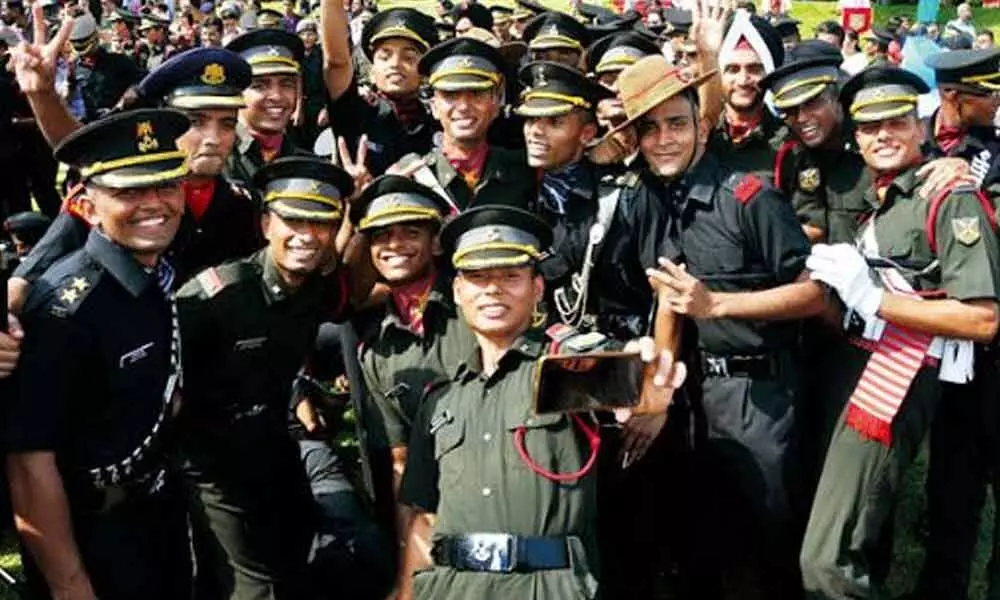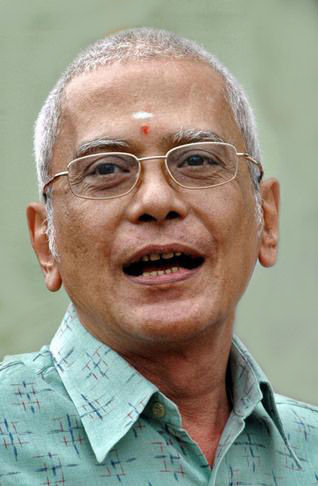Live
- Punjab DGP, MHA official request farmer leader Dallewal to end 20-day fast
- Stage Collapse During Swearing-In Ceremony of KUDA chairman in Kakinada
- Govt unveils ‘Jalvahak’ to boost inland waterways
- List of criminals: Delhi BJP chief on AAP panel of 38 candidates
- PSBs in India clock record Rs 1.41 lakh crore in net profit in FY24
- Telangana Government Announces Key Development Plans: Bhatti Vikramarka
- Crackdown on illegal poppy farming in Manipur: Assam Rifles destroyed 6,228 acres in 5 years
- South Korea's ruling party leader cancels press conference amid calls for resignation
- AIADMK's big meet discusses 2026 polls, prospective alliances
- BJP questions Congress-Shiv Sena (UBT) alliance over Aaditya Thackeray's Savarkar-Nehru remark
Just In

Indians and the Armed Forces
They are everywhere, advertisements exhorting people to join the Armed Forces. They extol the advantages of service in the military, and call upon the youth to join the heady quest for excitement, adventure and honour.
They are everywhere, advertisements exhorting people to join the Armed Forces. They extol the advantages of service in the military, and call upon the youth to join the heady quest for excitement, adventure and honour. They tell you that, apart from the patriotic spirit being satisfied, one will be looked up to in society, and enjoy a quality of life that goes with the best of the careers on offer.
Response to these calls, however, varies sharply as one travels away from the northern parts of the country. Every other family, in states such as Rajasthan or Punjab, will usually have sent a daughter or a son to one of the forces. Not so, however, in States such as, say, Gujarat or Andhra Pradesh.
Historically, peninsular India has been relatively immune to external aggression. Even the long coastline has rarely, if ever, been exposed to hostile attacks. Also, India has neither been an imperialistic country seeking to expand its influence to lands across the seas, nor a seafaring nation, in trade and commerce. On the other hand, invasions from the northwest have been frequent in the history of India. Over time, those areas produced tough, hardy, courageous and fearless people, not unfamiliar with the travails that come with living in close proximity to enemies across the border.
Thus, over the centuries, peninsular India lived in relative security and prosperity, literally with its hair let down and feet put up. People indulged in peacetime luxuries such as the fine arts, including literature, music, dance etc. with the rulers of different kingdoms extending enthusiastic patronage and support. Save the occasional skirmish, triggered by envy or greed, between and amongst themselves, the rulers had little to do with defending the borders of the country against external attacks.
All this is neither to take away from the great and significant achievements the northern States have to their credit in the fields of higher education, culture and the arts, nor to detract from the valour and courage that people from the south have shown on various occasions, when internal as well as external challenges tested the country's peoples. The mention of a few names such as Bade Ghulam Ali Khan, Ravi Shankar, Alluri Sitharama Raju, Veerapandiya Kattabomman and Subramanya Bharati should suffice to illustrate the point. Similarly, in the military sphere, significant contributions have come from the South and the East from stalwarts including Shivaji, Subhas Chandra Bose, General Cariappa, General Thimmayya and General Sam Manekshaw.
A quick look at the numbers shows that the state of Punjab, for instance, contributes 2.4 per cent to the population of the country while accounting for 16.6 per cent of the Armed Forces. Somewhat similarly, the numbers for Haryana, are 2.2 and 7.82. On the other hand the state of Gujarat has sent a mere 3199 people to the Forces between 2015 and 2018. While Andhra Pradesh contributes less than a fourth of what Punjab does, Telangana contributes only about 10 per cent of the same.
Those numbers were merely by way of illustrating the point that the attraction the Armed Forces offer to the youth of the country is certainly a function of geography and, in turn, a host of other factors including exposure to external threats, inherited qualities relating to patriotism and honour etc.
I was brought up just as any other middle-class south Indian boy and therefore, had little exposure to the military way of life, almost until I completed my training in the Lal Bahadur Shastri National Academy for Administration (LBSNAA), at Mussoorie and reported in the district. Even the little exposure one would have normally had to the 'military' way of life (through what was known as the 'army attachment', an integral part of the training at the LBSNAA) was denied to the group of three to which I belonged, ostensibly on account of the preparations on for the imminent engagement with Pakistan on account of the (then) East Bengal uprising, we were sent to cool or heels with a battalion of the Grenadiers Regiment at Jabalpur.
That was a rather dull and uneventful experience, brightened for a brief while when yours faithfully was asked to guide a marching unit at night, compass in hand. The neighbouring state was only a few kilometres away when the Commander of the unit gently retrieved the instrument from my hands, and suggested that, perhaps, finding my bearings at night was not my best suit, after all!
My next contact with the Army happened only when I was Sub-Collector at Ongole during the Andhra agitation. The Army was brought in as the entire administration had come to a standstill on account of the agitating masses, with only the highest echelons of the police and civil services available. They did the usual 'route march' and restored calm and quiet. I developed a close contact with the Army contingent which came there and learnt quite a few things about how army does things.
Apart from a few arms' length relationships with the Armed Forces in the wake of the occurrence of natural disasters, I had, thereafter, little to do with the Armed Forces, until I became the Chief Secretary of (the then) Andhra Pradesh State in which capacity one dealt with the units of the Air Force and the Army at Hyderabad, and the Eastern Naval Command situated at Visakhapatnam.
Much later as a Member of the National Disaster Management Authority (NDMA), I dealt with them again, albeit in a limited manner, in seeking, and obtaining, their assistance in the raising, equipping and training the National Disaster Response Force (NDRF).
(The writer is former
Chief Secretary, Government
of Andhra Pradesh)Dr Mohan Kanda

© 2024 Hyderabad Media House Limited/The Hans India. All rights reserved. Powered by hocalwire.com







